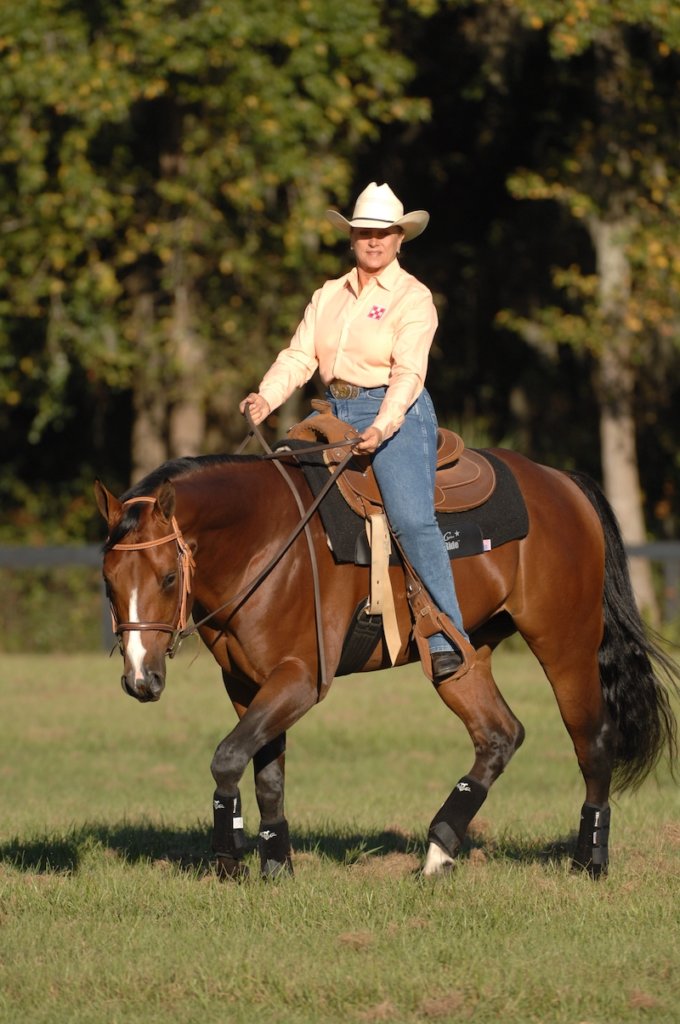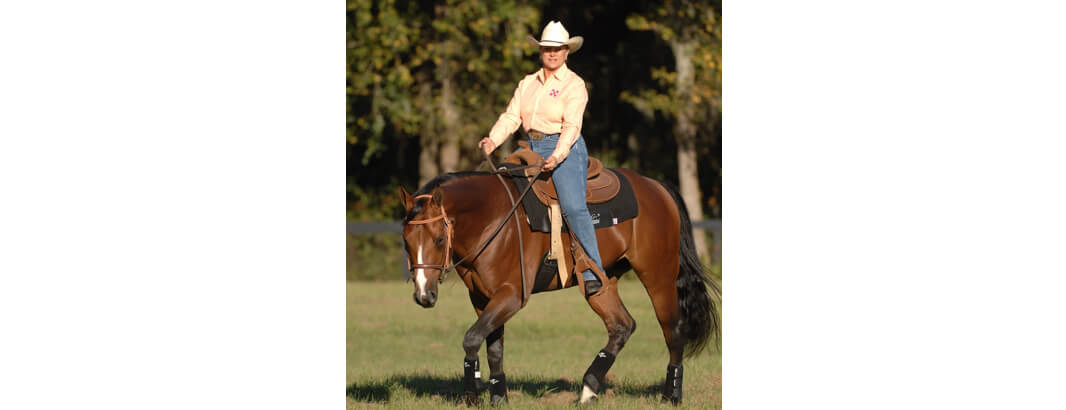Bending Aids and an Exercise
By Lynn Palm

Last month I described what correct bend is, and the aids to achieve it. In this article I’ll review the key points and give you an exercise to help train your horse to bend correctly.
Review of Bending
When a horse has proper bend in his body, his entire body is bent from the poll to tail—not just the head and neck. When a horse has this proper bend he is balanced, relaxed, easier to steer, and maintains the same speed.
Bending Aids
First, the active aids are used to achieve the correct bend and balance. These include the inside leg, which is used to bend the horse’s body, and an inside rein. Either an open or indirect (neck rein) is used to flex the horse’s head in the direction of travel.
Secondly, the supporting aids are applied. The outside leg keeps the horse’s hips from swinging out, and the outside rein against the neck (indirect or neck rein) keeps the shoulder from going out. The outside rein prevents the head and neck from bending too much.
Remember, when you bend your horse, you also have to ask him to turn! Your outside, supporting aids are always your turning aids as well. Don’t forget to support your horse’s bend with your inside leg and rein as you turn with your outside aids. This is how you achieve correct riding on a curve. Your horse will respond with lightness and smoothness while turning and he will be more willing to turn because he is balanced.
Bending Exercise
This exercise is an excellent one to practice on your own at home. You need eight pairs of cones to use as a visual for a circle. The cones in each pair should be set 6’ apart, with one cone placed in the middle of the circle. The diameter of the circle should be 70’ maximum. Here’s any easy tip to measure the circle without a tape measure:
Start at the middle cone and walk 12 large steps and place a cone (approximately 36’) then walk two large steps and place a second cone (approximately 6’). This is your first quarter of the circle. Continue with the other three quarters of the circle. Finally, make sure your quarter lines up with the quarter on the opposing side of the circle.
The goal of this exercise is to ride the curve of the circle consistently while maintaining the proper bend as described above. Keep your horse on the track of the circle. You must look ahead and stay in the middle of each pair of cones.
Begin at the walk, as the walk gives you time to feel what you are doing, but make sure your horse stays forward. I suggest working at an extended walk, which helps control your horse’s body position. The cones keep your eyes looking ahead to the next quarter of the circle. You will learn to feel more clearly how to execute your aids and how your horse responds.
Using Your Aids
Your inside leg bends the body while the open rein will flex the head inward. If your horse wants to move or turn inward with the open rein, then use an indirect or neck rein to ask the horse to flex the head inward, just enough so you see the inside eye. The indirect rein against the neck of your horse encourages your horse to yield to the pressure and move outward with the assistance of your inside leg. If you pull back with your inside rein you will feel tension there and there won’t be a bend in the neck. Your horse will resist and not stay on the circle.
Use your outside aids to support the bend. Your outside leg is further back to keep the horse’s hips slightly inward and your outside rein prevents the shoulders from going out or the head from turning too much to the inside.
Once the correct bend and balance is achieved at the walk, move to the trot. If your horse is wiggly on the circle, go to the trot and then back to the walk. Control the bend through the upward or downward transitions. If you can stay between the cones you are controlling the correct bend at all times! Your horse will be easy to steer, relaxed, and able to maintain consistent speed.
Helpful Hint
Don’t do more than three circles in each direction because your horse can become bored with circle work. After you complete two sets of circles in each direction, go practice something else and then return to the exercise, or leave it alone for the day. This particular exercise is good to do three or four times a week until you condition your horse to be strong with his bending and balance in each direction.
Don’t forget that all horses have an easy side and a hard side, and that to achieve a proper bend both legs and both hands must be active. Through practice you will achieve evenness and a strong balance for your horse!
Trainer’s Corner: How to Put Your Horse in Balance with Bending – Part 1
Lynn Palm is the author of The Rider’s Guide to Real Collection and Your Complete Guide to Western Dressage. Her accomplishments include 2007 American Quarter Horse Association (AQHA) Horsewoman of the Year; AQHA Female Equestrian of the Year by the Women’s Athletic Association; named one of the top United States clinicians by Horse & Rider magazine; recipient of over 40 World and Reserve World Champions in AQHA and WDAA; USEF Western Dressage Horse of the Year and multiple USDF Champions; AQHA, ARHA and USEF Western Dressage R Judge. Lynn has given more than 50 bridleless exhibitions at events including the National Horse Show, 1989 World Cup, the 1996 Atlanta Olympic Games, 1996 World Cup, World Equestrian Games, and FEI World Cup.






